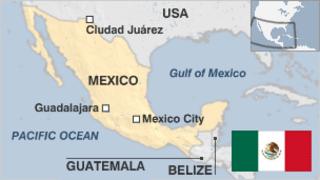Home » Latin America »
Mexico country profile
Mexico is a nation where affluence, poverty, natural splendour and urban blight rub shoulders.
It has the second-largest economy in Latin America, and is a major oil exporter.
But prosperity remains a dream for many Mexicans, and the socio-economic gap remains wide. Rural areas are often neglected, and huge shanty towns ring the cities.
Many poor Mexicans have sought to cross the 3,000-km border with the US in search of a job, but in recent years more Mexicans immigrants have returned to Mexico than migrated to the US.
Tens of thousands of people have been killed in drugs-related gang violence in the past decade. Powerful cartels control the trafficking of drugs from South America to the US. Security forces ordered to crack down on them have been accused of abusing their power and acting with impunity.
FACTS
United Mexican States
Capital: Mexico City
Population 116 million
Area 1.96 million sq km (758,449 sq miles)
Major language Spanish
Major religion Christianity
Life expectancy 75 years (men), 80 years (women)
Currency peso
LEADERS
President Andres Manuel López Obrador
The left-winger Andres Manuel López Obrador won an overwhelming victory in the July 2018 presidential election.
He says his priorities are to tackle corruption and reverse decades of free-market economic policy – which he blames for social inequality, endemic violence, and the desire of so many young people to leave the country is search of a better life.
Mr López Obrador, popularly known by his initials Amlo, is a former mayor of Mexico City, and stood for the presidency on two earlier occasions – losing to Enrique Peña Nieto of the centre-left Institutional Revolutionary Party in 2012.
He has pledged to set an example of personal probity by serving only one term, surrendering part of his salary, selling off his official plane, and not living in the presidential palace, while also proposing a law to allow the recall of any elected official by referendum.
MEDIA
Reporters Without Borders describes Mexico as “one of the hemisphere’s most dangerous countries” for the media.
Drug cartels and corrupt officials are implicated in most of the crimes of violence against journalists, which almost always go unpunished.
Two big players, Televisa and TV Azteca, dominate the TV sector.
Mexico is one of Latin America’s biggest internet markets.
TIMELINE
Some key dates in Mexico’s history:
1519 – Spanish army led by Hernan Cortes lands at Veracruz, marking the start of Spain’s conquest of Mexico.
1521-1820 – Mexico forms part of the Viceroyalty of New Spain.
1810-21 – War of Independence ends with the creation of the short-lived Mexican Empire, which includes Central America to the southern border of modern-day Costa Rica, as well as what is now the south-western US.
1824 – Mexico becomes a federal republic. Central American provinces secede.
1846-8 – Mexican-American War ends with Mexico being forced to sell its northern provinces (including modern-day California, Nevada, New Mexico, Arizona and Utah) to the US.
1910-1920 – Mexican Revolution leads to establishment of a constitutional republic.
1929 – Formation of the National Revolutionary Party, which later becomes the Institutional Revolutionary Party, or PRI, which dominates politics until 2000.
1968 – Student demonstration in Mexico City during the Olympic Games is fired upon by Mexican security forces. Hundreds of protesters are killed or wounded.
1976 – Huge offshore oil reserves discovered.
1994 – Zapatista rebels, led by the charismatic Subcommander Marcos, rise up demanding improved rights for some 10 million Indians in Mexico, four million of whom live in Chiapas.
2000 – Vicente Fox breaks ruling PRI party’s seven-decade dominance by winning presidential election.
2006 – President Felipe Calderon launches crackdown on drug gangs, with violence escalating into a national security crisis.
2018 – Left-wing former mayor of Mexico City, Andres Manuel López Obrador, wins an overwhelming victory in presidential elections.
Source: Read Full Article



